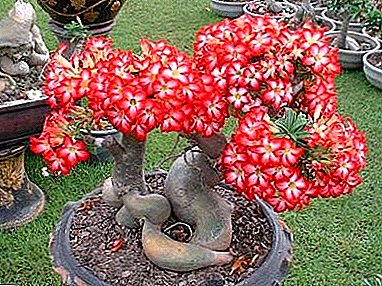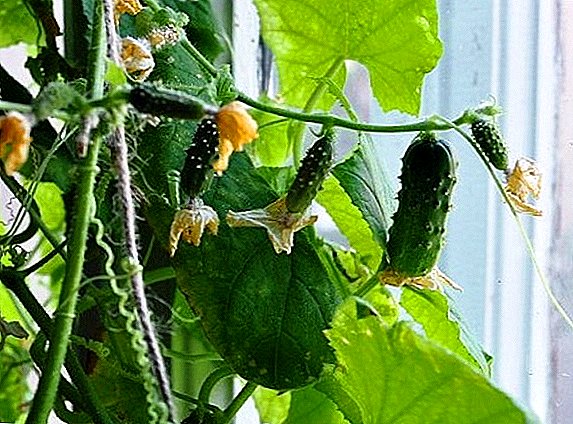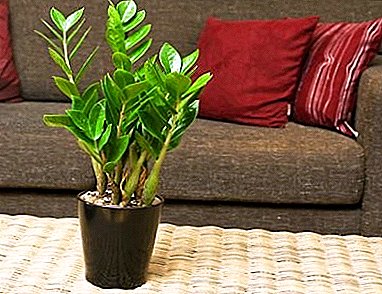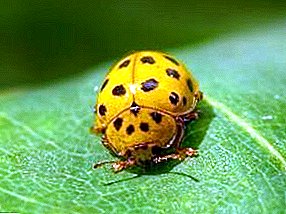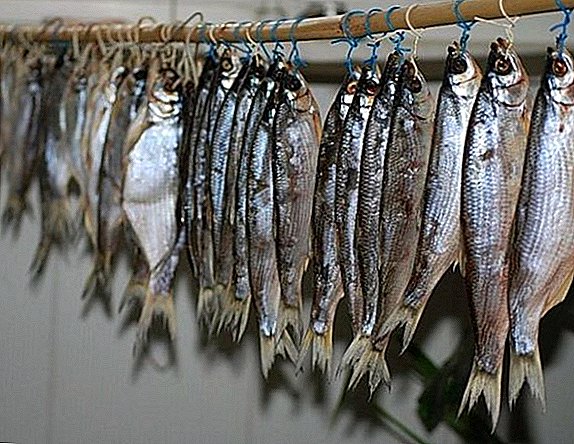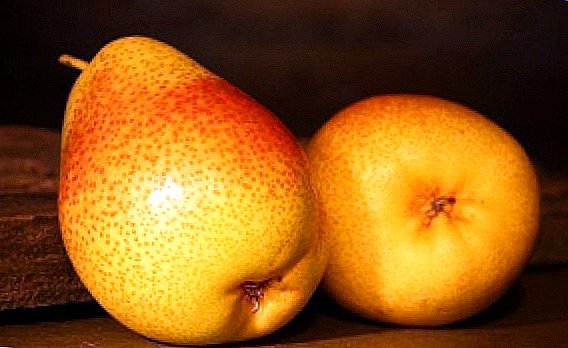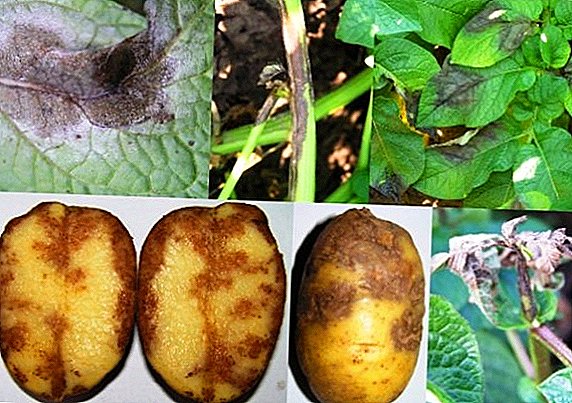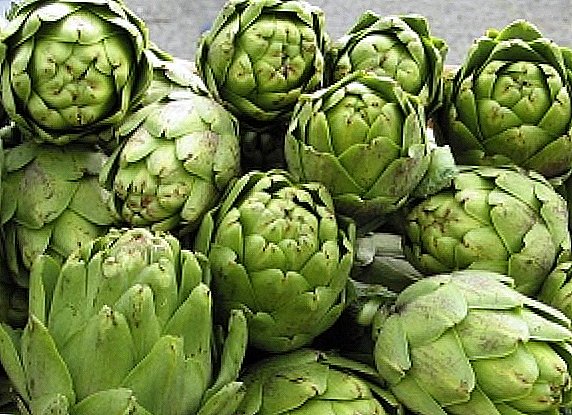
Supermarket shelves simply collapse from a huge number of different fruits and vegetables, most of which we are not even able to determine.
Considering that spending money on such “overseas wonders” is the same as throwing it away to the wind, sometimes we don’t even think about the amount of nutrients they hide in themselves.
Take at least artichokes - awkward bumps, which, however, have an unusually pleasant taste, and are very healthy.
Moreover, they are quite realistic to grow in their own backyard, receiving very good yields.
Have you decided to grow artichokes? Get acquainted with the plant closer and do the preliminary preparation

In general, artichokes can be described as a very large plant, which can even reach 2 meters in height. At the same time, it is a perennial, that is, after a one-time planting, for a very long period of time it will delight you with its crops.
The bush of this plant itself is different in that its basal rosette consists of very powerful and prickly leaves.
For cultivation in the conditions of the climate of Russia and Ukraine, the plant is adapted quite well, it transfers the winter without problems under the ball of organic fertilizers, which can be used as hay, leaves, sawdust.
In the northern region of Russia, in order to preserve the vital activity of the bush, it must be excavated for the winter and stored in a very dark place with cool air until spring comes.
Some difficulty in growing artichokes in our countries is that today there are no seeds of this plant that have been zoned for us.
Of course, that the most outcast enthusiasts have long grown popular foreign varieties, including "May", "Green Ball", "Roman Violet". Moreover, if you are already seriously gathered to start growing this vegetable, then you should know that it does not reproduce only with seeds.
Very good results of growth are given by its breeding by root branches, but for this it is imperative to have friends with whom the artichoke in the garden has been growing for several years already. To buy the cuttings of this plant in any specialized nurseries is not possible, since they are simply not there.
Artichoke seed preparation: do they need vernalization?

Vernalization of seeds involves a procedure when the seeds are exposed to low temperatures for a period of time. It is believed that with such processing of seeds of artichokes before their direct planting, it is possible to significantly increase the yield, and in the first year after planting feast on these delicious fruits. But, many gardeners claim that the opposite can cause the death of plants.
The fact is that in 70% of the plant actually blooms already in the first year after planting, and it is really possible to remove a small crop from it, but such an unnatural flowering can cause very serious damage to the plant.
In particular, it not only weakens, but also spends the forces needed to strengthen itself on flowers and fruits, as a result it becomes unable to endure even one winter. In principle, the method will be good in the case when the artichoke is planted exclusively for one-time production of fruits, and the bush is not expected to grow for many years.
Essence and stages of jarovization are as follows:
- Begin vernalization should be in the first half of February.
- Seeds are poured evenly into the box for seedlings on wet sand.
- In this state, the seeds are for 6-10 days at air temperature from 22 to 25 ºС, until they begin to germinate.
- During the whole time of germinating seeds, the sand under them should be kept wet by spraying it with water.
- The immediate vernalization is that the box with the “sunken” seeds needs to be sent to the bottom shelf of the refrigerator for 15 days and kept at a temperature of 0 ° C. Evidence that the seeds are ready for planting will be the darkened tips of their roots.
If you still decided to abandon the vernalization, then before sowing the seeds will still need to germinate. To do this, they are kept for some time in ducks, then they are wrapped in a wet cloth and kept warm. With such cultivation, seedlings should appear within 5-6 days.
It is also interesting to read about growing asparagus.
We are engaged in preparing beds for artichokes: what kind of soil and what fertilizers does a plant need?

Externally, artichokes have some similarities with weeds, in particular with the thistle. But still, he is a cultivated plant, and therefore, to develop and bear fruit anywhere, he will not.
In particular, on depleted soils and in shaded places, the plant may not even bloom, as a result of which it will not even be necessary to talk about the harvest. For this reason, for planting artichokes should choose a very comfortable and lighted place with a high level of soil fertility.
Also, it is important to take into account such soil characteristics as looseness, lightness and good ability to pass through moisture.
The immediate preparation of the soil will be to dig a hole and to bring in into her a large amount of fertilizer different type.
The depth of the pit is approximately 60 centimeters, and the width is 1 meter. Next, fill it with ingredients in the following order:
- A 10 cm layer of expanded clay / clay shards / pebbles / synthetic winterizer is laid on the bottom, which will serve as a drainage in the future.
- Pour on top of the drainage a land mixture of 3 parts of land taken from your garden, 3 parts of ordinary sand, 3 parts of humus and 1 part of peat.
A pit prepared with this type is well-suited not only for planting seeds, but also for growing artichokes with the help of root branches, that is, seedlings. Before planting, the soil in the pit should also be slightly moistened.
We grow seedlings from artichoke seeds: main aspects of sowing
Dates and other features of sowing artichokes

It is necessary to sow seedlings very early, so that by the approach of a suitable time for planting seedlings in open ground, it can develop well and grow stronger. The most ideal time for this is the very beginning of spring - the first half of March.
It is better to sow them in wooden boxes, in which a special earthen mixture is poured from equal-sized hardwood, humus and sand. In order for the seeds to germinate better from the ground, this soil in the box must also be kept constantly moist.
Until the appearance of the very first shoots, the boxes with seeds sown in them are kept in a greenhouse, greenhouse or directly in an apartment or house, observing the temperature regime not lower than + 18-20ºС.
Slightly grown plants, which will have time to appear the first real leaf (usually it happens after 10-15 days), you can swoop down. The pick lies in the fact that each plant should be transplanted into a separate container. It is for this reason that the scheme of sowing seeds does not matter, since the seedlings are transplanted in the future anyway.
When diving should take into account the fact that the seedlings of artichokes has a fairly large size, so the capacity for it is necessary to choose large. Ideal - peat-purulent pots, a volume of at least 0.5 liters.
In order to influence the formation of a powerful root system in the future artichoke bush, when picking you need to pinch off the root tip. However, do not overdo it so as not to harm the plants.
How should care be provided with artichoke seedlings?
A lot of attention does not require artichoke seedlings after picking. It usually takes root well, so plant replacement is not necessary. The only thing is that the soil in the pots needs to be constantly moistened, and also to prevent the formation of weeds in it.
But besides this, it is very important feed the plants. In particular, already after the expiration of 2 weeks from the moment of the picking, the soil with seedlings is fertilized with the help of mullein.
For this, the fertilizer is diluted with water in the ratio of 1 to 10. Another two weeks later, the artichoke seedlings are re-feeding, but this time it is necessary to use mineral fertilizers, not organic matter.
Also, in order for the seedlings to be prepared as best as possible for growth in the open field, it is necessary to quench it.
To do this, cups of seedlings for the day should be brought out into the street, so that the plants not only adapt to real air temperatures, but also to bright sunshine.
Planted seedlings in open ground can begin as early as mid-May, unless of course the temperature of the air on the street has been established sufficiently warm and stable.
Seedlings of artichokes and the rules of its planting in open ground
When can I plant artichokes on the beds?

Above we have already mentioned that the planting of seedlings of artichokes can be started from the middle of May. However, it is best to focus on the climatic features of your region, since even in mid-May there are often frosts in areas that are at and above Moscow latitude.
Thus, planting can be delayed until the summer itself, so it will take a long time and troublesome to tinker with seedlings. It will also need to continue to be taken out for quenching, to provide support for growth.
However, you can risk planting it in open ground, but constantly cover the plants at night with a film. Sometimes special wire arches are installed over the bed, over which it is convenient to stretch the protective film without causing damage to the plants themselves.
Which planting pattern is more beneficial for artichoke seedlings?
The planting scheme of the seedlings of the described plant directly depends on the size it achieves in adulthood. We have already mentioned that its height can even reach 2 meters, while the vegetative mass also accumulates an impressive one. Based on the foregoing, it is recommended that seedlings of artichokes be planted in a square-nested manner.
It lies in the fact that between the rows and the plants left the same space, which in the case of artichokes reaches 70 centimeters (that is, the scheme 70h70). In one nest, that is a hole for seedlings, two plants are planted.
How we need to prepare the holes for the artichokes, we have already written, but we also mention that you should not plant seedlings very deep into the ground. The root system of this plant is sufficiently developed, so it can hold tight, without even requiring hilling.
Artichokes on your beds and care for them: what is important to consider and what should not be forgotten?
Do I need to water the artichoke bushes and how often should it be done?

Moisten the soil in which artichokes grow should be regularly and abundantly.
Watering it is possible less often - only 2 times a week, however at the same time it is possible to bring about 5 liters of water.
The larger the plant becomes, the more moisture it needs. However, too much overdoing can also be dangerous, especially if the soil absorbs moisture poorly or the ground waters are very close to the ground.
Also, it is very important to focus on the amount of natural precipitation and on their regularity. In general, do not allow excessive dryness of the soil - and you will achieve good results in growing artichokes.
Loosening the soil around the artichokes and removing weeds
The next day after each watering of the plants, the soil around them must be loosened. This is done with the aim of not forming a crust on its surface, which prevents the penetration of air.
Also, it is important to constantly weed the beds with artichokes from various weeds, which are particularly dangerous at the very beginning of plant growth.
Feeding artichokes: what fertilizers are recommended to use?

Fertilizing this plant is necessary to carry out, because they respond best to them. At the same time, a good result is shown both organic and mineral fertilizers.
But, besides the usual root artichokes with cow dung or mineral fertilizers, which are usually held every 15 days, it is important to carry out foliar feeding.
Their essence lies in the fact that the plants are sprayed with special solutions, which include:
- Potassium chloride (10 grams).
- Wood ash (10 grams).
- Superphosphate (25 grams).
The regularity of such spraying should not be too high, it will be enough once a month. Their great advantage lies in the fact that this not only increases the level of trace elements in the plant, but also prevents its defeat by aphids and butterflies.
We harbor the plant for the winter - save it until next year
After harvesting, autumn wilting of the plant and the arrival of the first cold, the aboveground part of the artichoke bush is completely cut off. In order to prevent the roots of the plant from being damaged by frost, the soil should be covered with rhizomes for the diameter of the soil with the help of opal leaves or straw.
Also, in winter, it is possible to specially wrap up more snow on the beds, which will retain heat in the soil.
Harvesting artichokes: how to determine the desired ripeness?

If you used vernalization for growing artichokes, then harvest will be possible in the first year, although in natural conditions this happens only in the second. In particular, you yourself will notice that among the lowered prickly leaves of this plant appeared flower stalks.
The first artichokes will be suitable for consumption after 2 weeks. A little opened top in their upper part testifies about it.
The big difficulty in collecting artichokes is that the flowers bloom at one and the same time, therefore, the maturity of each of them is separately determined, and also cut from the bush separately. For larger artichokes, it is recommended to leave only 2-3 peduncles on each plant with 3-4 baskets on each.
Also, by no means the plant must not be allowed to flower fully, because in such a state the artichoke heads are very hard and become unsuitable for consumption.
So, if at the very top of the artichoke you see blue petals, you can consider this vegetable as unfit for human consumption.
Artichokes collected from the bush can be stored for a sufficiently long period of time, which is their very important advantage. In particular, if the described vegetables are contained at a temperature of from 0 to + 1ºС, then as a result it will be possible for them to taste another 2-3 months.


